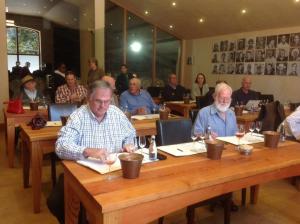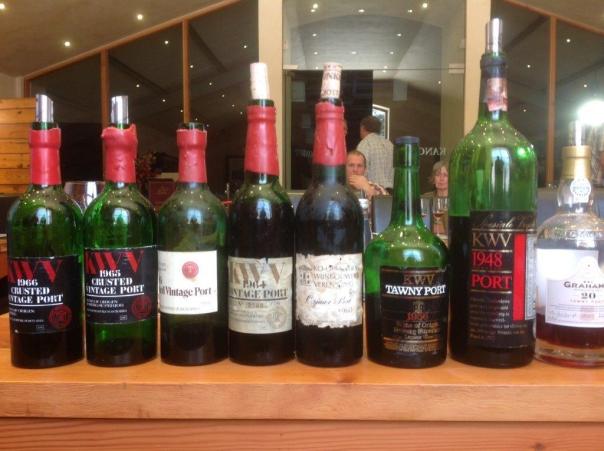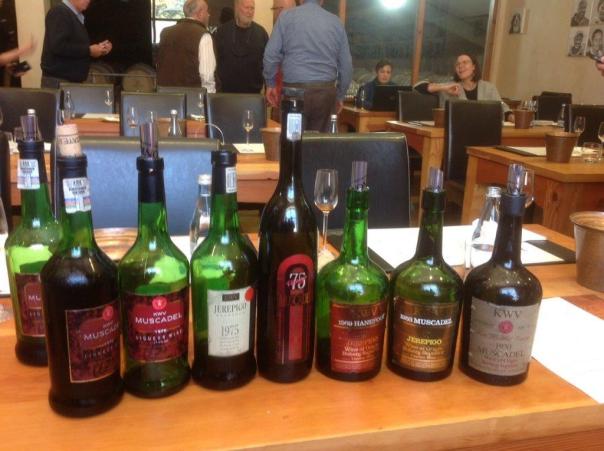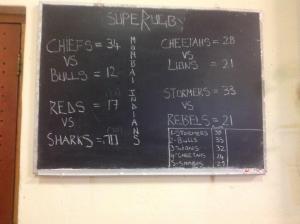Get together with a few folk you haven’t seen in years and it’s amazing how everyone looks the same and it feels like yesterday you saw each other!

It’s just as pleasant a surprise when the wines – the youngest a 40 year old 1975 KWV Muscadel Jerepigo – still taste sprightly and full of life.
Both were happy experiences at a tasting of old (and I mean old) KWV Port styles, Muscadels and Hanepoots, kindly arranged by Kanonkop’s Johann Krige; the wines those he’d purchased during his time as Marketing Manager for KWV.
Fortified wines are hardly the flavour of the month, Muscadels even less so than Port styles, the latter recognised as some of the best in the world after those from the Douro Valley. How sad can this be, especially when many are readily available – 2004 Wood Matured Muscadel and 1996 Tawny from Monis are two examples. KWV themselves possibly also have some of their older gems for sale.
Krige told his guests that according to the late Fanie Malan of Allesverloren, air conditioners and TV accounted for the decline in consumption. I can think of many other reasons today: the preference for lighter, fresher wines and drink/driving issues. It’s also true these wines tend to be poured at the end of the meal, when everyone’s had sufficient white and red wines.
But marketing is an issue too; the Muscadel Association keeps its annual competition so low-key to be almost a non-event. More song and dance generally, please producers!

Background info to the Port-styles – seven with one Port, Grahams 20 year old Tawny, a good sighter for the locals – was provided by Charl Theron (Gary Baumgarten did the same for the Muscadels; both men had worked at the KWV from 1980 to 1995, so are pretty well informed about these wines).
Actual vinification, according to a strict recipe, took place on farms such as Allesverloren and Bredells. The main varieties, souzão, tinta roriz, tinta francisca and cinsaut, were harvested around 24 to 28 Balling, had a good dose of sulphur added, fermented down to 13 Balling when the maximum colour had been extracted, before being fortified with brandy spirits or eau de vie. Residual sugar would be around 120 to 130 grams/litre.
It’s only since 1985, when South African producers visited Portugal, that we’ve seen drier wines with higher alcohols.
Four wines labelled Crusted Vintage were poured first: 1966, 1965, 1964 and 1963, all would have been aged in bottle. The oldest and youngest were still very much alive; deep, dark walnut in colour with high-toned nutty, dried fruit, earthy notes; rich in texture but also having good spirit attack.
Colours in these oldies are a thing of wonder: brilliant mahogany with a halo of glowing green, especially on the 1956 Tawny. Just as invigorating was a note of boot polish (not unpleasant!) on that and the vintage 1960. Can you believe the Tawny sold for R17 a bottle on release, something that was in doubt as Baumgarten sat down to blend it.
An off-spin of the last wine up cost a great deal more than R17. What didn’t make the KWV 1948 bottling was, so Theron told us, sold in bulk to then Stellenbosch Farmers’ Winery, making its way into the famous Monis Collectors Port. On the 2011 Nederburg Auction, six bottles sold for R68 000! Our KWV now is rich, viscous and comforting. Comforting is, I think, a good description for these wines: they suggest a happy state of mind when accompanied by a good book and good music.
After some reverential sipping – with not much spitting involved – we took a break before turning to the Muscadels – actually five of those plus two Hanepoots.

The muscadels, Baumgarten informed us, were all made from the red version of muscat blanc a petit grains, while both muscats were harvested between 24 – 28 Balling, sulphur and tartaric acid (160 grams/ton) added and just six hours of skin contact from crush to fortification with 96% brandy spirits.
Of course, muscadels have a history of prompting stories; Baumgarten didn’t disappoint with one that featured a ‘dry’ matric dance and a handy bootful of samples! Cue much laughter.
How gorgeous was that whispy muscat fragrance, freshness, intensity and harmony in the pair of 1975 Muscadels, one WO Robertson, the other WO Breederivier Valley, but both aged in 10 000 litre stukvats (like those in the Cathedral Cellar). The hanepoot seemed quiet by comparison.
The wine I was longing to try again was the famous 1953 Muscadel Jerepigo, voted the best South African entry on the infamous 1995 SAA Shield (more about that later this year). It was made in a different way from other muscadels being left overnight to ferment on the skins, which made it less sweet, though more viscous and complex with more structure than the others. It’ll last for ever!
If asked to choose between the 1953 and 1930 Muscadel Late Bottled, the last wine in our line up and made by Prof Perold of pinotage fame, I couldn’t. ‘It was like syrup when removed from the stukvat,’ commented Baumgarten, ‘and was freshened with some of that 1975.’
By now we were into the really naughty tales Duimpie Bayly relating how one of the shorter guys on the Wine & Spirit Board tasting panel always pressed the blue button indicating ‘superior’, simply because that was the only one he could reach!
This memorable treat was followed by a traditional Kanonkop snoek braai, some of their older wines and, no doubt, many more rowdy-inducing stories!
